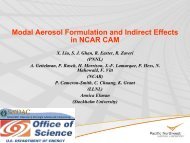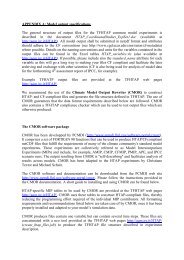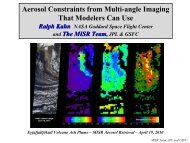大æ°ç©çå¦ç¹è« ï¼ï¼ï¼ï¼ ï¼å¤§å¦é¢çå·¥å¦æè²é¨ä¿®å£«èª²ç¨ï¼ - AeroCom
大æ°ç©çå¦ç¹è« ï¼ï¼ï¼ï¼ ï¼å¤§å¦é¢çå·¥å¦æè²é¨ä¿®å£«èª²ç¨ï¼ - AeroCom
大æ°ç©çå¦ç¹è« ï¼ï¼ï¼ï¼ ï¼å¤§å¦é¢çå·¥å¦æè²é¨ä¿®å£«èª²ç¨ï¼ - AeroCom
Create successful ePaper yourself
Turn your PDF publications into a flip-book with our unique Google optimized e-Paper software.
10th <strong>AeroCom</strong> Workshop(Fukuoka:2011.10.5, Kazuma Aoki)
Tateyama Research Laboratory<br />
University of Toyama<br />
Mt. Tateyama/Jodo (2839m)<br />
Snow layer 646 cm (Apr, 2011)<br />
Murodo-daira (2450m)<br />
10th <strong>AeroCom</strong> Workshop(Fukuoka:2011.10.5, Kazuma Aoki)
Table of Contents<br />
• What is the SKYNET sky radiometers network<br />
and Sky radiometer observation method<br />
• Spatial and temporal variation of aerosol<br />
climatology over Japan<br />
• SPRINTARS vs. Sky radiometer<br />
• Effect of cloud and other problem<br />
• Summary<br />
10th <strong>AeroCom</strong> Workshop(Fukuoka:2011.10.5, Kazuma Aoki)
AERONET (NASA/GSFC)<br />
SKYNET (CEReS)<br />
KSNET: Korean Skyradiometer network<br />
ESR: European Skyrad user network<br />
10th <strong>AeroCom</strong> Workshop(Fukuoka:2011.10.5, Kazuma Aoki)
AERONET (NASA/GSFC)<br />
SKYNET (CEReS)<br />
KSNET: Korean Skyradiometer network<br />
ESR: European Skyrad user network<br />
10th <strong>AeroCom</strong> Workshop(Fukuoka:2011.10.5, Kazuma Aoki)
What is the SKYNET<br />
(Prof. Takamura, CEReS, Chiba Univ.: http://atmos.cr.chibau.ac.jp/)<br />
SKYNET super site<br />
Cape Hedo, Okinawa, Japan (NIES)<br />
1. SKYNET is a network to measure the atmospheric radiation budget and<br />
related atmospheric parameters, such as aerosol, cloud and so on.<br />
2. SKYNET has an objective to estimate climatic impacts due to atmospheric<br />
parameters.<br />
3. SKYNET is a useful validation network for satellite products (ADEOS-I, II,<br />
GOSAT, GCOM & etc) and numerical model (SPRINTARS & etc).<br />
4. SKYNET project is a grass roots effort by many researchers who are<br />
interested in above items.<br />
10th <strong>AeroCom</strong> Workshop(Fukuoka:2011.10.5, Kazuma Aoki)
About 50 site in the world<br />
Sky radiometer observatory<br />
Kazuma Aoki@Univ.Toyama (kazuma @sci.u-toyama.ac.jp)<br />
@ SKYNET/Sky (Univ. Toyama)<br />
+ KSNET: Korean Skyradiometer<br />
network<br />
+ ESR: European Skyrad user network<br />
@ SKYNET/Flux (SNU)<br />
@ SKYNET/Lidar (NIES)<br />
@ SKYNET/Microwave (CEReS)<br />
@ SKYNET/Model (RIAM)<br />
@ etc<br />
We started the long-term monitoring of aerosols since 1994, by using a sky<br />
radiometer (Prede Co. Ltd.,) on SKYNET project. We are seeking in this data<br />
information on the aerosol and cloud optical characteristics with respect to their<br />
temporal and spatial variability and validation of Satellite and models<br />
10th <strong>AeroCom</strong> Workshop(Fukuoka:2011.10.5, Kazuma Aoki)
Detail of sky radiometer<br />
Ground-based<br />
Ship-borne<br />
Aoki and Fujiyoshi, 2003, JMSJ<br />
• We observed only in daytime under<br />
clear skies at each site.<br />
• Every 10 min/once (aureole)<br />
• Every 1 min/once (direct)<br />
• Data have been analyzed by an<br />
inversion software called<br />
SKYRAD.pack (Nakajima et al.<br />
1996). Available version are<br />
SKYRAD.pack 4.2. L0, L1 and L2.<br />
• POM-01: 315, 400, 500, 675, 870,<br />
940, 1020 nm<br />
• POM-02: 315, 340, 380, 400, 500,<br />
675, 870, 940, 1020, 1627, 2200 nm<br />
10th <strong>AeroCom</strong> Workshop(Fukuoka:2011.10.5, Kazuma Aoki)
Comparison between SPRINTARS and SKYRAD<br />
SPRINTARS is based on a atmospheric general<br />
circulation model developed by Center for Climate<br />
System Research, University of Tokyo, National<br />
Institute for Environmental Studies, and Frontie r<br />
Research Center for Global Change<br />
(CCSR/NIES/FRCGC AGCM), and treats main<br />
tropospheric aerosols both from natural and<br />
anthropogenic sources (black carbon, organic matter,<br />
sulfate, soil dust, and sea salt). They are also<br />
categorized into PM10 and PM2.5. SPRINTARS<br />
calculates transport processes of aerosols (emission,<br />
advection, diffusion, wet deposition, dry deposition,<br />
and gravitational settling). The aerosol direct effect,<br />
which is scattering and absorption of solar and thermal<br />
radiation by aerosols, and the indirect effect, which is<br />
act of aerosols as cloud condensation nuclei and ice<br />
nuclei, are included in the calculation.<br />
Present specifications<br />
SPRINTARS version 3.84<br />
horizontal resolution: T213 (0.5625 degrees<br />
longitude/latitude) or T106 (1.125 degrees<br />
longitude/latitude) or T42 (2.8125 degrees<br />
longitude/latitude)<br />
vertical resolution: 56 or 20 layers (sigma coordinate)<br />
The Sky radiometer is a portable instrument that<br />
takes measurements only during daytime under<br />
clear sky condition. It observes both direct solar<br />
irradiance and diffuse sky radiation at every 10<br />
minutes.<br />
Present specifications<br />
SKYRAD.pack version 4.2 L1 and L2 data<br />
Aerosol optical thickness at each wavelength<br />
Ångström exponent<br />
Single scattering albedo at each wevelength<br />
Size distribution of volume<br />
etc<br />
10th <strong>AeroCom</strong> Workshop(Fukuoka:2011.10.5, Kazuma Aoki)
Kasuga (KSG)<br />
Since 2003<br />
Sapporo (SPK)<br />
since 1997<br />
Fukue-jima (FUJ)<br />
Since 2002<br />
Toyama (TOY)<br />
Since 2002<br />
Cape Hedo (CHD)<br />
Since 1996<br />
Nagasaki (NGS)<br />
Since 1996<br />
10th <strong>AeroCom</strong> Workshop(Fukuoka:2011.10.5, Kazuma Aoki)
Comparison between SPRINTARS and SKYRAD<br />
10th <strong>AeroCom</strong> Workshop(Fukuoka:2011.10.5, Kazuma Aoki)
Comparison between SPRINTARS and SKYRAD<br />
10th <strong>AeroCom</strong> Workshop(Fukuoka:2011.10.5, Kazuma Aoki)
Comparison between SPRINTARS and SKYRAD<br />
10th <strong>AeroCom</strong> Workshop(Fukuoka:2011.10.5, Kazuma Aoki)
Aerosol optical thickness at 0.5 µm<br />
2008.01 to 2010.12: Sapporo, Toyama, Kasuga/Fukuoka, Nagasaki, Fukue-jima, Cape Hedo<br />
10th <strong>AeroCom</strong> Workshop(Fukuoka:2011.10.5, Kazuma Aoki)
Ångström exponent<br />
2008.01 to 2010.12: Sapporo, Toyama, Kasuga/Fukuoka, Nagasaki, Fukue-jima, Cape Hedo<br />
10th <strong>AeroCom</strong> Workshop(Fukuoka:2011.10.5, Kazuma Aoki)
Single scattering albedo at 0.5 µm<br />
2008.01 to 2010.12: Sapporo, Toyama, Kasuga/Fukuoka, Nagasaki, Fukue-jima, Cape Hedo<br />
10th <strong>AeroCom</strong> Workshop(Fukuoka:2011.10.5, Kazuma Aoki)
Comparison between SPRINTARS and SKYRAD<br />
2008.01 to 2010.12: Sapporo, Toyama, Kasuga/Fukuoka, Nagasaki, Fukue-jima, Cape Hedo<br />
10th <strong>AeroCom</strong> Workshop(Fukuoka:2011.10.5, Kazuma Aoki)
Comparison between SPRINTARS and SKYRAD<br />
2008.01 to 2010.12: Sapporo, Toyama, Kasuga/Fukuoka, Nagasaki, Fukue-jima, Cape Hedo<br />
AOT500 Alpha SSA500<br />
clear-sky<br />
all-sky<br />
10th <strong>AeroCom</strong> Workshop(Fukuoka:2011.10.5, Kazuma Aoki)
Discussion<br />
What are we need data<br />
Indirect effect and effect of aerosols<br />
between cloud (include cloud screening)<br />
Comparison<br />
LIDAR, MAX-DOAS and other instruments<br />
Satellite, Model and other<br />
10th <strong>AeroCom</strong> Workshop(Fukuoka:2011.10.5, Kazuma Aoki)
What are we need data<br />
What is true Aerosol optical properties<br />
measured by sky scanning<br />
radiometer<br />
+ Quality control<br />
+ Stable instrumentation<br />
10th <strong>AeroCom</strong> Workshop(Fukuoka:2011.10.5, Kazuma Aoki)
Discussion<br />
What are we need data<br />
Indirect effect and effect of aerosols<br />
between cloud (include cloud screening)<br />
Comparison<br />
LIDAR, MAX-DOAS and other instruments<br />
Satellite, Model and other<br />
10th <strong>AeroCom</strong> Workshop(Fukuoka:2011.10.5, Kazuma Aoki)
Clear sky<br />
Effect of aerosols between clouds (Hybrid effect)<br />
Aerosol<br />
and/or Cloud<br />
Cloud<br />
Frequency distribution of τ (0.5) (%)<br />
20<br />
15<br />
10<br />
5<br />
τ(0.5) clear<br />
τ(0.5) cloud<br />
0<br />
0 0.5 1 1.5 2<br />
τ(0.5)<br />
Aoki and Fujiyoshi, 2003, JMSJ<br />
Frequency distribution of α (%)<br />
10<br />
8<br />
6<br />
4<br />
2<br />
α clear<br />
α cloud<br />
0<br />
0 0.5 1 1.5 2<br />
α<br />
We eliminated 30 to 70% of the initial data<br />
because of cloud conditions and other factors.<br />
The sky radiometer, however, measures optical<br />
properties of aerosols under partly cloudy<br />
conditions if there are no clouds within 30 of the<br />
solar aureole radiation distribution.<br />
Since the relative humidity is high under cloudy<br />
conditions, the optical properties of aerosols<br />
that exist in between clouds would be changed.<br />
To study the properties, we compare the optical<br />
properties of aerosols measured under partly<br />
cloudy conditions with those measured under<br />
fully fine weather conditions. It was found that<br />
the seasonal mean of AOT(0.5) (or Alpha)<br />
measured under cloudy conditions was 1.5 to<br />
1.8 (1.1 to 1.2) times as large (small) as that<br />
measured under clear skies.<br />
10th <strong>AeroCom</strong> Workshop(Fukuoka:2011.10.5, Kazuma Aoki)
Discussion<br />
What are we need data<br />
Indirect effect and effect of aerosols<br />
between cloud (include cloud screening)<br />
Comparison<br />
LIDAR, MAX-DOAS and other instruments<br />
Satellite, Model and other<br />
10th <strong>AeroCom</strong> Workshop(Fukuoka:2011.10.5, Kazuma Aoki)
Example of comparison results<br />
SKYRAD. vs. Lidar<br />
MR01-K02 (Nishizawa et al. 2007, JGR)<br />
SKYRAD. vs. SPRINTARS<br />
(Takemura et al. 2001, JMSJ)<br />
SKYRAD. vs. MAX-DOAS<br />
(Irie et al. 2008, ACP)<br />
10th <strong>AeroCom</strong> Workshop(Fukuoka:2011.10.5, Kazuma Aoki)
SKYENT/SKYRAD web:<br />
http://skyrad.sci.u-toyama.ac.jp<br />
toyama.ac.jp<br />
10th <strong>AeroCom</strong> Workshop(Fukuoka:2011.10.5, Kazuma Aoki)
If you need result of our sky radiometer, please contact me.<br />
kazuma@sci.u-toyama.ac.jp<br />
Thank you.<br />
10th <strong>AeroCom</strong> Workshop(Fukuoka:2011.10.5, Kazuma Aoki)








